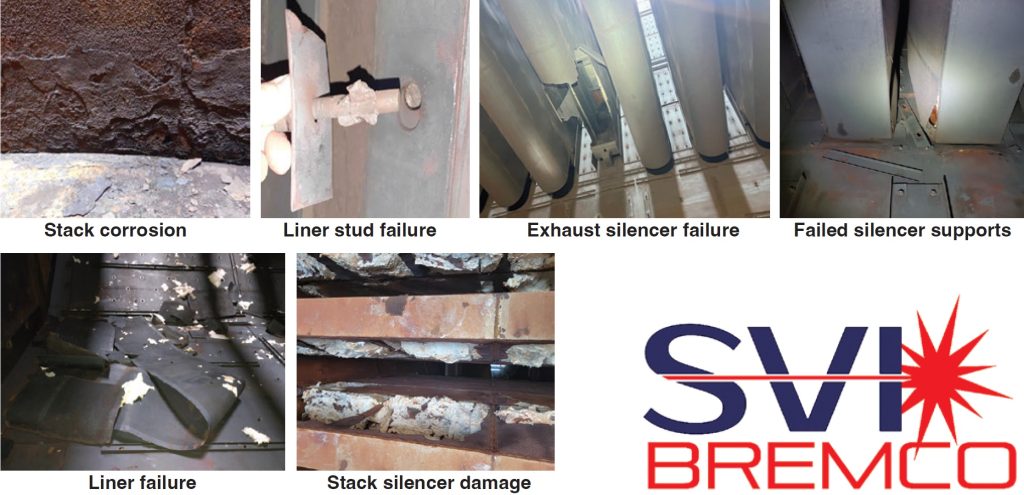
There are several reasons stacks don’t get much attention from operators on their rounds—among them:
- They’re static and there’s nothing much to see externally except perhaps peeling paint.
- Forgetting the switchyard, they’re likely a longer walk from the control room base than any other plant component.
- Internal access is not possible with the plant in operation.
This means you don’t know much about the true condition of your stack unless you make it a priority to conduct an internal and up-close external inspection annually. Regular inspections can identify problems before they cause an outage, a loss in performance, potential safety issue, etc.
SVI Dynamics’ Scott Shreeg identified several common failure points for a steel stack to be aware of when conducting your annual inspection (photos). They are:
- General corrosion.
- Stress or fatigue cracks caused by repetitive or excessive movement. These usually develop at openings or discontinuities in the metal.
- Buckling of the stack shell caused by corrosion thinning of the shell material.
- Cracking of the stack shell and its support structure from fatigue attributed to thermal cycling.
Annual inspection checklist
When perusing the list below keep in mind that the inspection and maintenance programs for unlined stacks (single wall) and stacks with a floating liner differ in some respects.
- Check bolts and nuts for degradation—including anchor bolts, those restraining platforms and ladders, etc.
- Examine the following for general condition, plus any evidence of corrosion and cracks in base metal and welds:
-
- Baseplate.
- Anchor chairs.
- Breech opening reinforcement.
- Shell plate.
- Circumference stiffeners.
- Shop and field joints (welded and bolted).
- Lateral supports.
- Access doors.
- Dynamic stability devices.
- Exterior conditions of test ports.
- Exterior lagging.
- Expansion joints.
- Grounding lugs and cables.
- Guy wires (visual check for degradation and broken wire strands), cable clamps, and anchors.
- Platforms and ladders: gratings, handrails, and platform supports.
- Outer shell-plate coating.
- Concrete foundation. If cracks are large, a follow-up concrete NDE may be necessary.
-
- Thermal imaging is recommended when the inspection must be performed with the unit in service. It is particularly helpful for detecting areas where excessive heat transfer exists because of liner or lagging insulation loss.
Triennial steel-stack inspection
- Visual inspection of shell plate for the full height of the stack.
- Random ultrasonic (UT) shell-plate thickness measurements every 10 ft from the bottom of the stack to the top.
- Follow-up with penetrant or UT inspections of questionable welds.
- Full-height interior visual inspection, including expansion joints.
- Drainage condition.
- Condition of silencers and their supports.
- Condition of turning vanes, flow dampers, and stack rain cap.
- Visual inspection for internal floating liner sheets, studs, insulation, batten channels.
When your stack needs go beyond simple inspection
SVI Dynamics has more than 25 years of experience in steel stack design, fabrication, construction, and inspection. This means the company can be a valuable partner for your plant, given its ability to determine the root cause of stack issues uncovered during an inspection and to suggest solutions using today’s most advanced engineering analysis software.
The company’s inspections are conducted to the widely accepted ASCE stack inspection code, with enhancements based on SVI’s experience. Inspections are supervised and reviewed by a registered professional engineer with details provided to the plant.
Inspection reports include the details of stack measurements taken, a summary of root-cause investigations conducted in response to defects found (if any), engineering calculations as needed to support decisions regarding stack structural integrity, and recommendations for follow-up inspection, repairs, and replacements.



